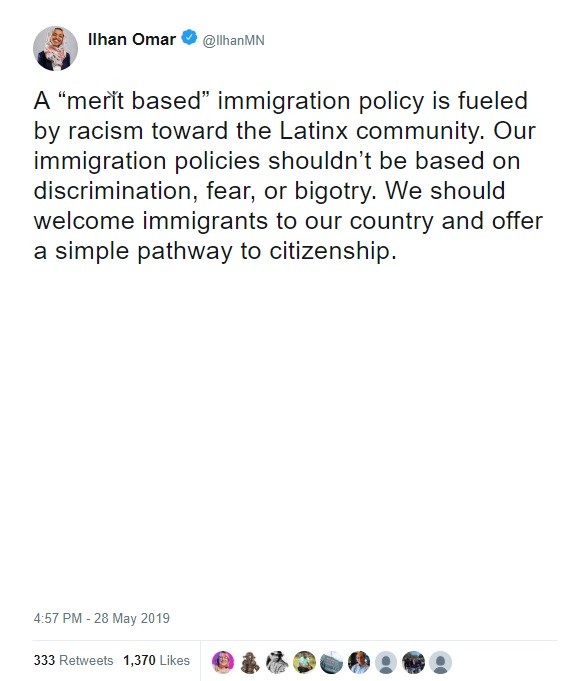Rep. Ilhan Omar posted and deleted a tweet which said that any immigration system which favors highly skilled people would be motivated by racism towards Latinos.
“A ‘merit based’ immigration policy is fueled by racism toward the Latinx community,” the Somali-born legislator tweeted May 28. “Our immigration policies shouldn’t be based on discrimination, fear, or bigotry. We should welcome immigrants to our country and offer a simple pathway to citizenship”:
The tweet was aimed at President Donald Trump’s draft immigration platform for 2020, which would reduce the inflow of chain-migrants and raise the inflow of migrants who can demonstrate their economic value and their support for American society.
Sen. Ted Cruz responded by Twitter:
As the son of a Cuban immigrant whose Dad came to get a math degree & become a computer programmer, I’m troubled that Dems seem to believe Hispanic immigrants can’t qualify for skills-based legal immigration. Bringing in more scientists, engineers & doctors is good for US jobs. https://t.co/iugniZgJtL
— Ted Cruz (@tedcruz) May 29, 2019
“Omar’s statement assumes that Hispanics could not make the cut in a merit-based system, which I assume is why she deleted the tweet,” noted Mark Krikorian, director of the Center for Immigration Studies. He continued:
But whatever the final criteria are when the White House plan is actually released, they’re guaranteed to be race-neutral, and there will be people of all kinds who could meet them. Given the existing migration patterns, though, Omar might be right that the share of Hispanics in the immigration flow would decrease, and Asians would probably increase.
The Asian share of green cards would likely increase under Trump’s plan because of the plan’s emphasis on workplace skills.
Immigrant Asians tend to be more educated and productive than Latinos, many of whom work in unskilled retail jobs or in tough and skilled manual-labor jobs. For example, a significant number of Chinese immigrants are university graduates and former H-1B visa-workers at U.S. research centers, while many Latinos have migrated from poverty into backbreaking jobs on California’s many l0w-tech farms.
Many Somali migrants arrive via chain-migration programs which would be sharply trimmed by Trump’s reform plan.
But Omar is making a race-focused argument against Trump’s color-blind reforms, Krikorian said. “Omar is herself making a racialist argument — i.e., she saying that any policy change that changes the national-origins makeup of the current immigration flow is “racist,” which is ridiculous.”
The legislator’s complaint does not detail a useful alternative to Trump’s plan, he added:
Putting aside Congresswoman Omar’s silly charge of anti-Hispanic animus, the real question is how does she want us to select immigrants? If not the merit-based system the president is proposing, then what? And how many immigrants does she think the U.S. should take annually? You can disagree with the White House approach, but only if you have some constructive alternative to propose.
In his May 16 address, Trump said:
Today, we are presenting a clear contrast: Democrats are proposing open borders, lower wages, and, frankly, lawless chaos. We are proposing an immigration plan that puts the jobs, wages, and safety of American workers first. Our proposal is pro-American, pro-immigrant, and pro-worker. It’s just common sense. It will help all of our people, including millions of devoted immigrants, to achieve the American Dream.
…
We will replace the existing green card categories with a new visa, the Build America visa — which is what we all want to hear.
Like Canada and so many other modern countries, we create an easy-to-navigate points-based selection system. You will get more points for being a younger worker, meaning you will contribute more to our social safety net. You will get more points for having a valuable skill, an offer of employment, an advanced education, or a plan to create jobs.
We lose people that want to start companies, and, in many cases, they’re forced to leave our country; go back, usually, to the country where they came from; and they’ll start up companies, and some of those companies are among the biggest and most successful companies today in the world. They could’ve started them right here in the United States, where they wanted to do it in the first place. Now they’ll have a chance.
Immigration Numbers to Know:
Each year, roughly four million young Americans join the workforce after graduating from high school or university.
But the federal government then imports about 1.1 million legal immigrants and refreshes a resident population of roughly 1.5 million white-collar visa workers — including roughly one million H-1B workers — and approximately 500,000 blue-collar visa workers.
The government also prints out more than one million work permits for foreigners, tolerates about eight million illegal workers, and does not punish companies for employing the hundreds of thousands of illegal migrants who sneak across the border or overstay their legal visas each year.
This policy of inflating the labor supply boosts economic growth for investors because it ensures that employers do not have to compete for American workers by offering higher wages and better working conditions.
This policy of flooding the market with cheap foreign white-collar graduates and blue-collar labor shifts also enormous wealth from young employees towards older investors even as it also widens wealth gaps, reduces high-tech investment, increases state and local tax burdens, and hurts children’s schools and college educations. It also pushes Americans away from high-tech careers and sidelines millions of marginalized Americans, including many who are now struggling with fentanyl addictions. The labor policy also moves business investment and wealth from the heartland to the coastal cities, explodes rents and housing costs, shrivels real estate values in the Midwest and rewards investors for creating low tech, labor-intensive workplaces.


COMMENTS
Please let us know if you're having issues with commenting.